Hitches and Towing 101
| CHAPTER CONTENTS | |
| 1. Introduction to Towing | 7. Brake Controls |
| 2. Towing Components | 8. Hitch Installation |
| 3. Types of Hitches | 9. Hooking Up |
| 4. Determining Tow Capacity | 10. Tow Bars/Dinghy Towing |
| 5. Selecting Your Hitch | 11. Towing Safety |
| 6. Wiring/Electrical | 12. Preparing Your Tow Vehicle |
Chapter 2 - Towing Components
The first things to learn about trailer towing are the names of the
various components and parts used to connect the vehicle and the trailer.
There's a whole range of terms devoted to towing, and you need to know the
correct names to make the right choices. The following definitions will be used
throughout this site, and each trailer hitch and towing definition includes a
pointer to another Chapter in this Hitches & Towing 101 guide that
provides more information about that component or part.
Tow
Vehicle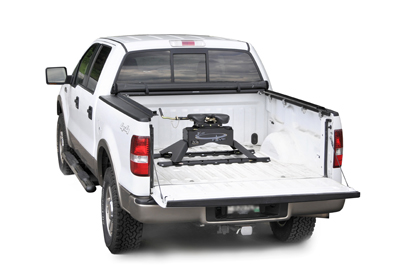 Your tow vehicle is the car, truck, van, or SUV you use to pull your trailer.
Depending on the make and model, your tow vehicle can safely tow up to
approximately 16,000 pounds with the right hitch. The largest pickup trucks can
tow up to approximately 25,000 pounds with a fifth wheel hitch. Your vehicle
owner's manual will tell you how many pounds your vehicle can tow safely. See
Chapter 4 for detailed information on determining
your vehicle's towing capacity and Chapter 12 for information on preparing your
vehicle for towing. Remember, never exceed the vehicle manufacturer's
specified weight capacity. The lowest rated towing component determines the
maximum you can safely tow.
Your tow vehicle is the car, truck, van, or SUV you use to pull your trailer.
Depending on the make and model, your tow vehicle can safely tow up to
approximately 16,000 pounds with the right hitch. The largest pickup trucks can
tow up to approximately 25,000 pounds with a fifth wheel hitch. Your vehicle
owner's manual will tell you how many pounds your vehicle can tow safely. See
Chapter 4 for detailed information on determining
your vehicle's towing capacity and Chapter 12 for information on preparing your
vehicle for towing. Remember, never exceed the vehicle manufacturer's
specified weight capacity. The lowest rated towing component determines the
maximum you can safely tow.
Table 2-1 shows examples of the variety of
towing capacities for a sampling of vehicles. Consult your owner's manual to be
certain of your vehicle's weight limits:
| Type of Vehicle | Example Models | Max Towing Capacity |
| Small car | Cobalt, Taurus, Avenger | under 1,000 pounds |
| Full-size car | Impala, Crown Victoria | 1,000-2,000 pounds |
| Mid-size CUV | Edge, Taurus X, Equinox | 2,000-4,000 pounds |
| Mid-size truck-SUV | Ranger, Trailblazer, Dakota | 3,000-7,200 pounds |
| Full size 1/2 ton truck or SUV | Expedition, F150, Tahoe, Durango Hybrid | 5,000-11,200 pounds |
| 1-ton or 3/4 ton truck or SUV | F250, Silverado HD, Ram 2500, F350, Ram 3500 | 10,000-16,000 pounds |
| Commercial Truck | F450 | 16,000
pounds 24,600 with fifth wheel |
| Class C or A RV | Marathon, Jamboree | up to 10,000 pounds |
Table 2-1: Example of a Variety of Vehicle Towing
Capacities
Trailer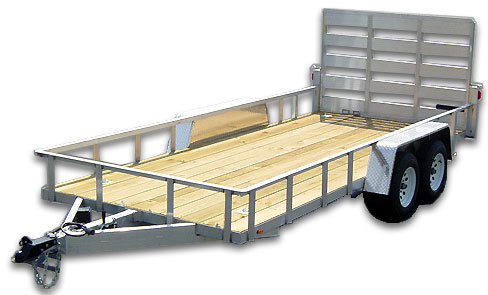
Any
wheeled construction designed to be pulled by another vehicle. Recreational,
Farm, and light commercial trailer types include camper/travel trailers,
livestock trailers, open utility and flatbed trailers, enclosed auto and gear
haulers, boat trailers, car-towing dollies, and even automobiles being
flat-towed with a tow bar. See Chapter 9 for information on hooking up
your trailer, and Chapter 10 for information on setting up and towing with a
dolly or flat-towing an automobile "dinghy-style" behind your
RV.
Tow Dolly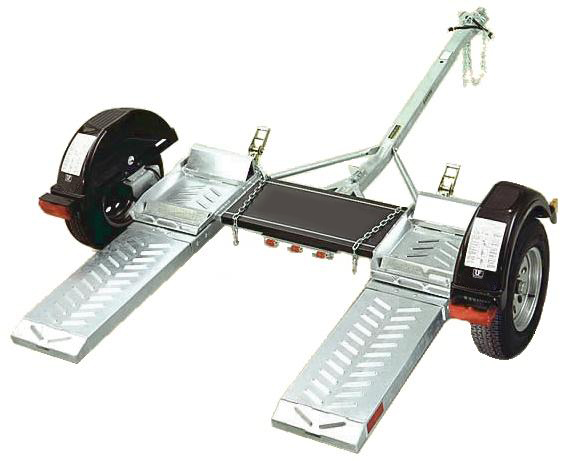
A
short two-wheeled trailer designed to cradle the front wheels of a car while
leaving the rear wheels on the road. These light-duty trailers are used for
short hauls or for dinghy-towing an automobile behind an RV or pickup with a
slide-in camper. See Chapter 10 for more information on tow bars &
dinghy towing.
Tow Bar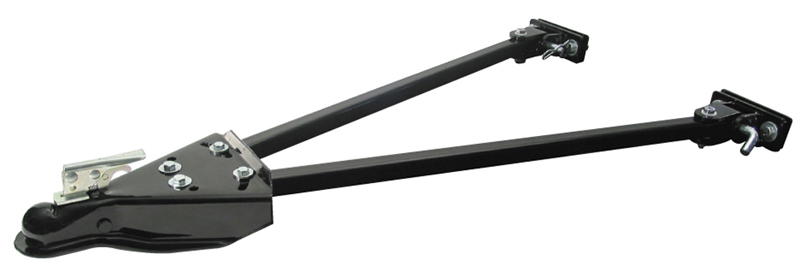
A V-shaped bar with a towing coupler designed to flat-tow a car behind an RV
or other tow vehicle. With a tow bar, the towed automobile is the trailer, while
the tow bar provides only the coupler and clearance from the rear of the tow
vehicle. Using a tow bar is often called towing "dinghy-style." See Chapter 10
for more information.
Trailer Lighting
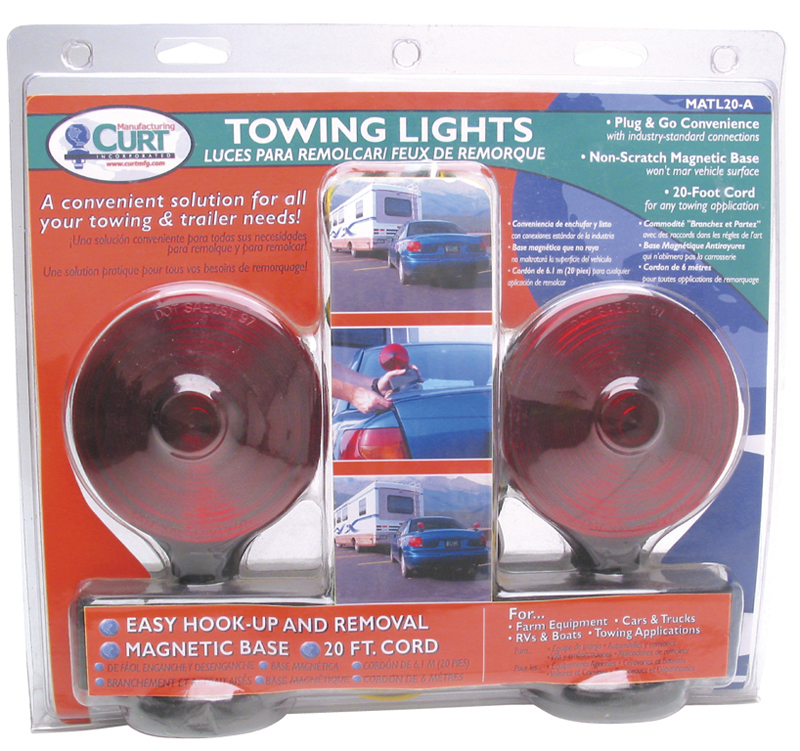
All trailers are required to have the same signaling lights as a powered
motor vehicle. The vast majority are legally required to carry taillights, turn
signals, and brake lights that are connected to the tow vehicle and actuated in
sync with the vehicle lights. See Chapter 6 for more information on lighting and
integrating trailer wiring with your tow vehicle.
Hitch
The point where a trailer is attached to your tow vehicle. Hitches range
from extremely light duty (a mounting point on the vehicle's
bumper*) to extremely heavy duty (a fifth-wheel attachment
located over a pickup truck's rear axle. Selecting the correct type of trailer
hitch for your tow vehicle's towing capacity, and your trailer's requirements is
a critical factor in successful towing. See Chapter 3 for complete
information on the available types of
trailer hitches. * Please note that although some bumpers are
rated for towing, they are rarely recommended. Working tongue weights often pull
the bumper down at an angle, which can compromise towing safety as well as
detract from the aesthetics of the
vehicle.
Weight Distributing
Hitch
A special device used to haul very heavy loads with conventional receiver
style hitches. A weight distributing hitch uses long rods called "spring bars"
that attach back to the trailer frame. These spring bars exert leverage on the
frame of the tow vehicle to distribute weight evenly between its rear and the
front wheels. For more information on weight
distribution hitches, see Chapter 3.
Hitch Ball
Mount
Also called a "stinger" or a "draw bar," the ball mount is a square steel
tube with a thick mounting plate to hold a hitch ball. These ball mounts are
made to be easily changed so that you can quickly use a variety of hitch balls.
The ball mount is held in place in the hitch with a special pin, or a locking
device. See Chapter 5 and Chapter 8 for more information on ball mounts.
Hitch Ball
Also called a "tow ball," the hitch ball is half of a flexible joint that
allows your tow vehicle and trailer to turn corners and navigate bumps and dips.
The coupler mounts and locks on top of the hitch ball and articulates around the
hitch ball. Recreational and light commercial hitch balls come in a variety of
sizes including 1 7/8-inch, 2-inch, 2 5/16-inch and rarely, 3-inch. In general,
lighter trailers use smaller hitch balls. While the diameter of hitch balls is
fairly standard, shank diameters and the hitch ball weight ratings may differ.
The rating of the hitch ball is just as important as the receiver hitch ratings
themselves. See Chapter 8 and Chapter 9 for more information about hitch balls.
Hitch Pin & Clip
This pin holds the ball mount in the hitch. It is also a convenient
attachment point for breakaway cables. Typically, a hitch pin is bent like a
hockey stick, and drilled at one end to accept a hairpin-shaped retaining clip.
A large bolt with a nut and a lock-washer is sometimes used in place of a hitch
pin. See Chapter 9 for more information on using a hitch pin and clip.
Trailer Wiring
Your trailer lights must be connected to your tow vehicle, and this requires
wiring from the lights forward to a connector at the back of the vehicle. There
are several standard formats for trailer connector wiring, with defined
locations for taillights, turn signals, brake lights and trailer brake
actuators. See Chapter 6 for information on trailer wiring
and connectors and Chapter 7 for information on trailer
brakes.
Coupler
The coupler is half of a flexible joint that allows your tow vehicle and
trailer to turn corners and navigate bumps and dips. The coupler fits over the
hitch ball, and is designed to articulate around the ball. The size of the
coupler and ball must match to operate safely. See Chapter 8 for information on
matching your coupler to a hitch, and Chapter 9 for instruction on hooking your
coupler to a hitch ball.
Safety Chain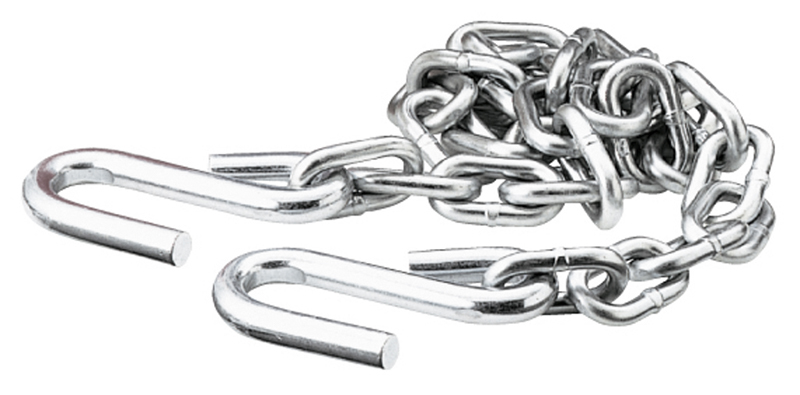
Every trailer requires at least one safety chain. This is simply a length of
chain strong enough to restrain the trailer from complete separation if the
hitch or coupler should fail. For heavier trailers, two safety chains are used,
and set up to cross under the coupler. In this way, if the coupler or hitch
fails, the nose of the trailer will be caught by the safety chains, providing a
measure of control while the tow vehicle stops. Use of safety chains is required
by most, if not all states. For more information on using safety chains, see
Chapter 11 on Towing
Safety.
| << Back to Chapter 1 | Go to Chapter 3 >> |




